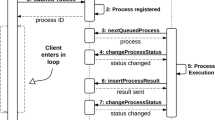Abstract
The grid design strongly depends on not only a network infrastructure but also a superstructure, that is, a social structure of virtual organizations where people trust each other, share resources and work together. Open Bioinformatics Grid (OBIGrid) is a grid aimed at building a cooperative bioinformatics environment for computer sicentists and biologists. In October 2003, OBIGrid consisted of 293 nodes with 492 CPUs provided by 27 sites at universities, laboratories and other enterprises, connected by a virtual private network over the Internet. So many organizations have participated because OBIGrid has been conscious of constructing a superstructure on a grid as well as a grid infrastructure. For the benefit of OBIGrid participants, we have developed a series of life science application services: an open bioinformatics environment (OBIEnv), a scalable genome database (OBISgd), a genome annotation system (OBITco), a biochemical network simulator (OBIYagns), and to name a few.
Similar content being viewed by others
References
Foster, I., Kesselman, S. and Tuecke, S., “The Anatomy of the Grid: Enabling Scalable Virtual Organizations,” Int. Journal of Supercomputer Applications, 15, 3, 2001.
Foster, I., Kesselman, C., Nick, J. and Tuecke, S., “The Physiology of the Grid: An Open Grid Services Architecture for Distributed Systems Integration,” Open Grid Service Infrastructure WG, Global Grid Forum, Jun., 22, 2002.
Konagaya, A., “OBIGrid: Towards a New Distributed Platform for Bioinformatics,” 21st IEEE Symposium on Reliable Distributed Systems (SRDS’02), pp. 380–381, 2002.
Konishi, F., Fukuzaki, F., Satou, K., Yamamoto, T., Defago, X. and Konagaya, A., “OBIGrid: A New Computing Platfrom for Bioinformatics,”Genome Informatics, 13, pp. 484–485, 2002.
Hatakeyama, M., Kimura, S., Naka, T., Kawasaki, T., Yumoto, N., Ichikawa, M., Kim, J. H., Saito, K., Saeki, M., Shirouzu, M., Yokoyama, S. and Konagaya, A., “A Computational Model on the Modulation of Mitogen-activated Protein Kinase (MAPK) and Akt Pathways in Heregulin-induced ErbB Signaling,” Journal of Biochemistry, 373, pp. 451–463, 2003.
Shampine, L. F. and Reichelt, M. W., “The Matlab ODE Suite,” SIAM Journal of Scientific Computing, 18, pp. 1–22, 1997.
Author information
Authors and Affiliations
Additional information
Akihiko Konagaya, Dr.Eng.: He is Project Director of Bioinformatics Group, RIKEN Genomic Sciences Center. He received his B.S. and M.S. from Tokyo Institute of Technology in 1978 and 1980 in Informatics Science, and joined NEC Corporation in 1980, Japan Advanced Institute of Science and Technology in 1997, RIKEN GSC in 2003. His research covers wide area from computer architectures to bioinformatics. He has been much involved into the Open Bioinformatics Grid project since 2002.
Fumikazu Konishi, Dr.Eng.: He is researcher at Bioinformatics Group, RIKEN Genomic Sciences Center since 2000. He received his M.S. (1996) and Ph.D. (2001) from Tokyo Metropolitan Institute of Technology. He served as an assistant in Department of Production and Information Systems Engineering, Tokyo Metropolitan Institute of Technology since 2000. He also works in Structurome Research Group, RIKEN Harima Institute from 2001. His research interests include concurrent engineering, bioinformatics and the Grid. He has deeply affected to the design of OBIGrid.
Mariko Hatakeyama, Ph.D.: She recieved her Ph.D. degree from Tokyo University of Agriculture and Technology. She is Research Scientist at Bioinformactis Group, RIKEN Genomic Sciences Center. Her research topics are: microbiology, enzymology and signal transduction of mammalian cells. She is now working on computational simulation of signal transduction systems and on thermophilic bacteria project.
Kenji Satou, Ph.D.: He is Associate Professor of School of Knowledge Science at Japan Advanced Institute of Science and Technology. He received B.S., M.E. and Ph.D. degrees from Kyushu University, in 1987, 1989 and 1995 respectively. For each degree, he majored in computer engineering. His research interests have progressed from deductive database application through data mining to Grid computing and natural language processing. His current field of research is bioinformatics. He prefers set-oriented manner of thinking, and usually wonders how he can construct an intelligent-looking system based on large amount of heterogeneous data and computer resources.
About this article
Cite this article
Konagaya, A., Konishi, F., Hatakeyama, M. et al. The superstructure toward open bioinformatics grid. New Gener Comput 22, 167–176 (2004). https://doi.org/10.1007/BF03040955
Received:
Revised:
Issue Date:
DOI: https://doi.org/10.1007/BF03040955




